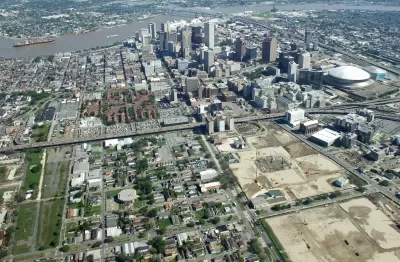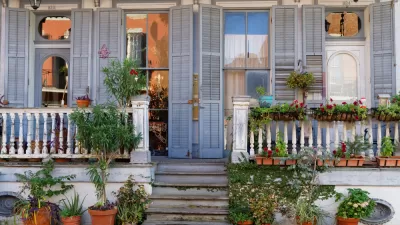In the aftermath of Katrina, President Obama's Choice Neighborhoods initiative promised thousands of new affordable units. But so far the Housing Authority of New Orleans hasn't proved up to the task.

In an article for Next City, Katy Reckdahl tells the halting story of New Orleans public housing after the flood. Following an extended period of inaction, four years ago "a trapezoid-shaped, 300-square-block section of the city [was] targeted for a major federal 'transformation' through the Choice Neighborhoods initiative heralded as a keystone of President Barack Obama's urban agenda."
"Yet the federal government also may have over-estimated its signature initiative, which awarded its first high-profile Choice Neighborhood grants to five cities in 2011 but was only able to give them a combined $122 million [...] If construction continues at the same pace in coming years, the promised 2,314 apartments won't be complete until 2026."
The relative scantiness of Choice Neighborhoods funding slows results. "'$350 million, spread over the U.S. for distressed neighborhoods is a drop in the bucket,' said Anthony Sanders, a professor of finance at George Mason University."
In addition, infrastructural inadequacies make it difficult to secure the investment necessary to fully finance the projects. Reckdahl writes, "New developments usually became islands of shiny, colorful buildings stuck in still-troubled neighborhoods with sporadic bus service, poor schools and little green space."
Meanwhile, the Housing Authority of New Orleans (HANO) has been hesitant to make its records public. "A broader context was impossible to get from HANO, since its staff refused to turn over the progress reports that HUD requires it send each quarter."
FULL STORY: 10 Years After Katrina, New Orleans Public Housing Still in Limbo

Study: Maui’s Plan to Convert Vacation Rentals to Long-Term Housing Could Cause Nearly $1 Billion Economic Loss
The plan would reduce visitor accommodation by 25,% resulting in 1,900 jobs lost.

North Texas Transit Leaders Tout Benefits of TOD for Growing Region
At a summit focused on transit-oriented development, policymakers discussed how North Texas’ expanded light rail system can serve as a tool for economic growth.

Why Should We Subsidize Public Transportation?
Many public transit agencies face financial stress due to rising costs, declining fare revenue, and declining subsidies. Transit advocates must provide a strong business case for increasing public transit funding.

How to Make US Trains Faster
Changes to boarding platforms and a switch to electric trains could improve U.S. passenger rail service without the added cost of high-speed rail.

Columbia’s Revitalized ‘Loop’ Is a Hub for Local Entrepreneurs
A focus on small businesses is helping a commercial corridor in Columbia, Missouri thrive.

Invasive Insect Threatens Minnesota’s Ash Forests
The Emerald Ash Borer is a rapidly spreading invasive pest threatening Minnesota’s ash trees, and homeowners are encouraged to plant diverse replacement species, avoid moving ash firewood, and monitor for signs of infestation.
Urban Design for Planners 1: Software Tools
This six-course series explores essential urban design concepts using open source software and equips planners with the tools they need to participate fully in the urban design process.
Planning for Universal Design
Learn the tools for implementing Universal Design in planning regulations.
Ascent Environmental
Borough of Carlisle
Institute for Housing and Urban Development Studies (IHS)
City of Grandview
Harvard GSD Executive Education
Toledo-Lucas County Plan Commissions
Salt Lake City
NYU Wagner Graduate School of Public Service




























